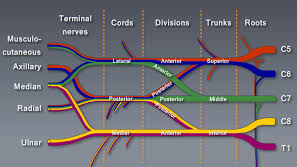Brachial Plexus
.png) The brachial plexus is the network of nerves that sends signals from your spine to your shoulder, arm and hand. A brachial plexus injury occurs when these nerves are stretched, compressed, or in the most serious cases, ripped apart or torn away from the spinal cord.
The brachial plexus is the network of nerves that sends signals from your spine to your shoulder, arm and hand. A brachial plexus injury occurs when these nerves are stretched, compressed, or in the most serious cases, ripped apart or torn away from the spinal cord.
The most severe brachial plexus injuries usually result from auto or motorcycle accidents. Severe brachial plexus injuries can leave your arm paralyzed, with a loss of function and sensation.
Minor damage often occurs during contact sports, such as football or wrestling, when the brachial plexus nerves get stretched or compressed. These are called stingers or burners, and can produce
- A feeling like an electric shock or a burning sensation shooting down your arm
- Numbness and weakness in your arm
More-severe injuries can include:
- Weakness or inability to use certain muscles in your hand, arm or shoulder
- Complete lack of movement and feeling in your arm, including your shoulder and hand
- Severe pain

A correct treatment of brachial plexus injuries needs multiple and different competences possibly coordinated by the same person/s
- Advanced diagnostic (clinical, neurophysiology, imaging)
- Primary neurosurgical repair
- Treatment of neuropathic pain
- Physical therapy and rehabilitation
- Secondary palliative surgery
How is it diagnosed?
The diagnosis is usually clear on taking a history, and examining which usually defines the nerves involved. This is then further confirmed by doing Electrophysiological tests such as Electromyography (EMG) or Nerve Conduction Velocity (NCV). Sometimes an MRI may be required for clarifying the kind of injury.
How is it treated?
In case the nerve has been cut by a sharp instrument in an accident, early surgery is recommended to achieve the best results. In case the injury is blunt or due to undue sudden stretching of the nerve, usually it is preferable to wait for up to 3 months to allow for normal recovery. After such time, it is necessary to undergo surgery to achieve chance of return of function.
Are there any alternatives?
The other alternative is to wait and do physiotherapy. In special situations, no nerve Transfer or repair may be possible, in which case you may consult an Orthopedic Surgeon for doing tendon transfers, or fusing joints in convenient positions.
What will happen if it is left untreated?
After 1 year of leaving a nerve or Brachial Plexus Injury untreated, there is very little even after successful surgery.
OPERATION: The incision is made along the course of the nerve or along an existing injury scar, or as best determined by the Neurosurgeon. Additional incisions may be required to obtain donor nerves if required. The site of injury is explored and after that, considering the status of the involved nerves, and using intra operative nerve stimulation with tiny currents, the exact surgical plan is formulated. The repair, and transfer procedure to obtain the best function is then performed.
RISKS OF THIS PROCEDURE
While majority of patients have an uneventful surgery and recovery, few cases may be associated with complications. These are seen infrequently and not all the ones listed below are applicable to one individual. However it is important that you are aware of the complications/risks that may arise out of this procedure which are as below:
- Infection, especially if there was a previous wound
- Temporary worsening of the existing weakness or numbness
- Swelling of the arm or leg, rarely leading to a compartment syndrome requiring reoperation.
 for conditions like Brain Tumor, Stroke, Spine Surgery, Movement Disorder, Aneurysm, Headache, Epilepsy, etc. _ AGRIM NEUROSERVICES_files/AGRIM-NEUROSERVCES.png)


